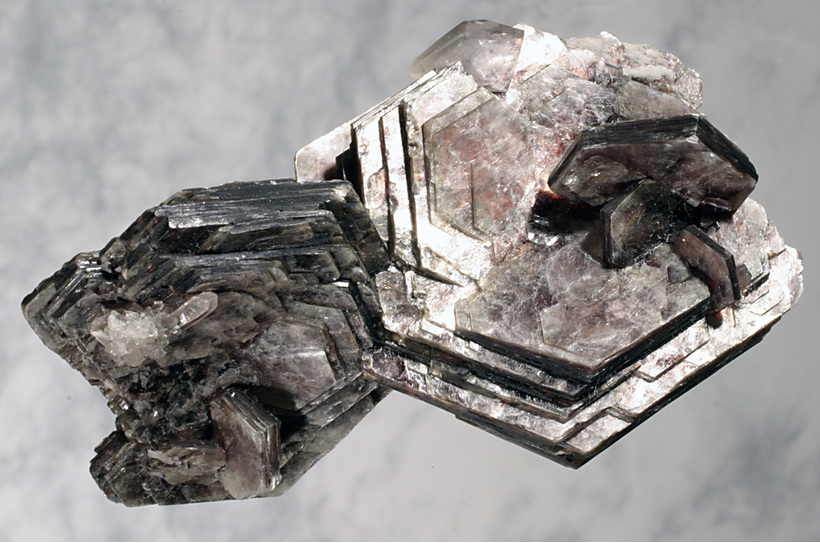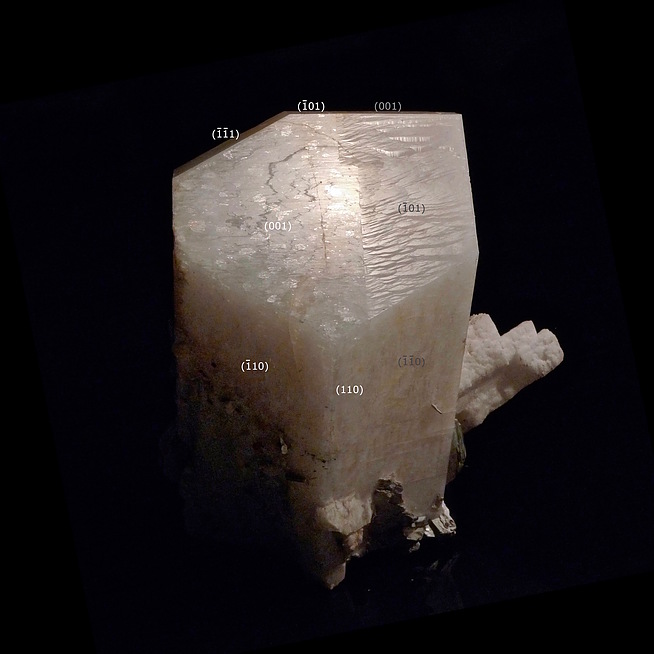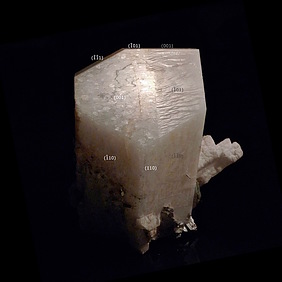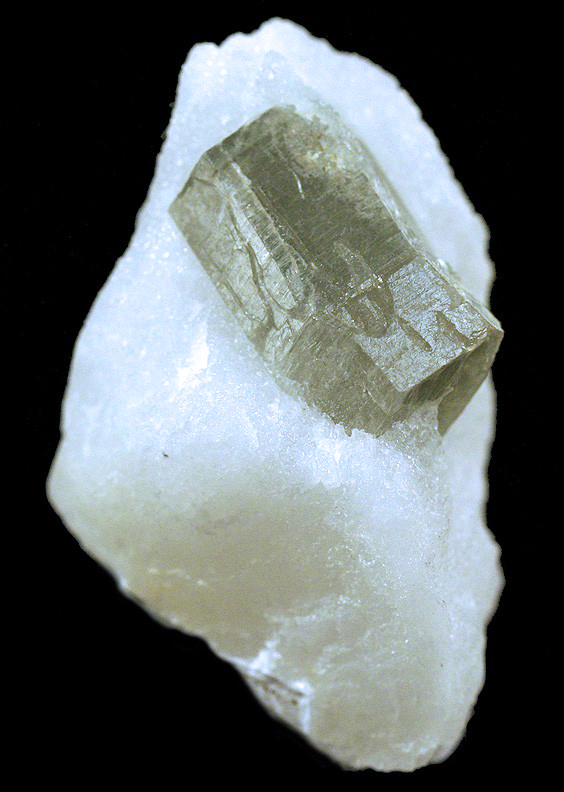The mineralogy of Potassium
| General Properties | |
|---|---|
| Symbol: | K |
| Atomic Number: | 19 |
| Standard atomic weight (Ar): | 39.0983(1) |
| Electron configuration: | [Ar] 4s1 |
| Photos | ||
|---|---|---|
| < | Potassium pearls under paraffin oil | > |
| Atomic Properties | |
|---|---|
| Electronegativity (Pauling scale): | 0.82 |
| Atomic Radius: | 243 pm |
| Ionic Radius: | 138 pm (+1) |
| Van der Waals Radius: | 275 pm |
| 1st Ionization energy: | 419 kJ/mol |
| 1st Electron affinity: | -48 kJ/mol |
| Oxidation States: | 1 |
| Physical Properties | |
|---|---|
| Standard State: | solid |
| Bonding Type: | metallic |
| Melting Point: | 337 K |
| Boiling Point: | 1032 K |
| Density: | 0.86 g/cm3 |
| Metal/Non-Metal: | alkali metal |
| Main isotopes of Potassium | ||||
|---|---|---|---|---|
| Isotope | % in Nature | Half Life | Decay type | Decay product |
| 39K | 93.26% | stable | ||
| 40K | 0.012% | 12.48(3)×109y | β− | 40Ca |
| ε | 40Ar | |||
| β+ | 40Ar | |||
| 41K | 6.73% | stable | ||
| Main ions of Potassium | ||||
|---|---|---|---|---|
| Name | Ion | Example minerals | ||
| potassium | K+ | Sylvite, Niter | ||
| Other Information | |
|---|---|
| Year Discovered: | 1807 |
| Discovered By: | |
| Year Isolated: | 1807 |
| Isolated By: | Humphry Davy |
| Named For: | from the English word "potash" |
| CPK color coding: | #8F40D4 |
| External Links: | WikipediaWebElementsLos Alamos National LaboratoryTheodore Gray's PeriodicTable.com |
| Simple Compounds and Mineral Names | |||||||||||||||||||||||||||||||||||||||||||||||||||||||||||||||||||||||||||||||||||||||||||||||||||||||||||||||||||||||||||||||||||||||||||||||||||||||
|---|---|---|---|---|---|---|---|---|---|---|---|---|---|---|---|---|---|---|---|---|---|---|---|---|---|---|---|---|---|---|---|---|---|---|---|---|---|---|---|---|---|---|---|---|---|---|---|---|---|---|---|---|---|---|---|---|---|---|---|---|---|---|---|---|---|---|---|---|---|---|---|---|---|---|---|---|---|---|---|---|---|---|---|---|---|---|---|---|---|---|---|---|---|---|---|---|---|---|---|---|---|---|---|---|---|---|---|---|---|---|---|---|---|---|---|---|---|---|---|---|---|---|---|---|---|---|---|---|---|---|---|---|---|---|---|---|---|---|---|---|---|---|---|---|---|---|---|---|---|---|---|
| Sulfides | dipotassium sulphide | K2S | +1 | ||||||||||||||||||||||||||||||||||||||||||||||||||||||||||||||||||||||||||||||||||||||||||||||||||||||||||||||||||||||||||||||||||||||||||||||||||||
| dipotassium disulphide | K2S2 | +1 | |||||||||||||||||||||||||||||||||||||||||||||||||||||||||||||||||||||||||||||||||||||||||||||||||||||||||||||||||||||||||||||||||||||||||||||||||||||
| dipotassium hexasulphide | K2S6 | +1 | |||||||||||||||||||||||||||||||||||||||||||||||||||||||||||||||||||||||||||||||||||||||||||||||||||||||||||||||||||||||||||||||||||||||||||||||||||||
| dipotassium trisulphide | K2S3 | +1 | |||||||||||||||||||||||||||||||||||||||||||||||||||||||||||||||||||||||||||||||||||||||||||||||||||||||||||||||||||||||||||||||||||||||||||||||||||||
| dipotassium pentasulphide | K2S5 | +1 | |||||||||||||||||||||||||||||||||||||||||||||||||||||||||||||||||||||||||||||||||||||||||||||||||||||||||||||||||||||||||||||||||||||||||||||||||||||
| dipotassium tetrasulphide | K2S4 | +1 | |||||||||||||||||||||||||||||||||||||||||||||||||||||||||||||||||||||||||||||||||||||||||||||||||||||||||||||||||||||||||||||||||||||||||||||||||||||
| Selenides | dipotassium selenide | K2Se | +1 | ||||||||||||||||||||||||||||||||||||||||||||||||||||||||||||||||||||||||||||||||||||||||||||||||||||||||||||||||||||||||||||||||||||||||||||||||||||
| Tellurides | dipotassium telluride | K2Te | +1 | ||||||||||||||||||||||||||||||||||||||||||||||||||||||||||||||||||||||||||||||||||||||||||||||||||||||||||||||||||||||||||||||||||||||||||||||||||||
| Hydrides | potassium hydride | KH | +1 | ||||||||||||||||||||||||||||||||||||||||||||||||||||||||||||||||||||||||||||||||||||||||||||||||||||||||||||||||||||||||||||||||||||||||||||||||||||
| Hydroxides | potassium hydroxide | KOH | +1 | ||||||||||||||||||||||||||||||||||||||||||||||||||||||||||||||||||||||||||||||||||||||||||||||||||||||||||||||||||||||||||||||||||||||||||||||||||||
| Fluorides | potassium fluoride | KF | +1 | Carobbiite | |||||||||||||||||||||||||||||||||||||||||||||||||||||||||||||||||||||||||||||||||||||||||||||||||||||||||||||||||||||||||||||||||||||||||||||||||||
| Chlorides | potassium chloride | KCl | +1 | Sylvite | |||||||||||||||||||||||||||||||||||||||||||||||||||||||||||||||||||||||||||||||||||||||||||||||||||||||||||||||||||||||||||||||||||||||||||||||||||
| Iodides | potassium iodide | KI | +1 | ||||||||||||||||||||||||||||||||||||||||||||||||||||||||||||||||||||||||||||||||||||||||||||||||||||||||||||||||||||||||||||||||||||||||||||||||||||
| Oxides | dipotassium oxide | K2O | +1 | ||||||||||||||||||||||||||||||||||||||||||||||||||||||||||||||||||||||||||||||||||||||||||||||||||||||||||||||||||||||||||||||||||||||||||||||||||||
| potassium superoxide | KO2 | +1 | |||||||||||||||||||||||||||||||||||||||||||||||||||||||||||||||||||||||||||||||||||||||||||||||||||||||||||||||||||||||||||||||||||||||||||||||||||||
| dipotassium peroxide | K2O2 | +1 | |||||||||||||||||||||||||||||||||||||||||||||||||||||||||||||||||||||||||||||||||||||||||||||||||||||||||||||||||||||||||||||||||||||||||||||||||||||
| Carbonates | potassium carbonate | K2CO3 | +1 | ||||||||||||||||||||||||||||||||||||||||||||||||||||||||||||||||||||||||||||||||||||||||||||||||||||||||||||||||||||||||||||||||||||||||||||||||||||
| Nitrates | potassium nitrate | KNO3 | +1 | Niter | |||||||||||||||||||||||||||||||||||||||||||||||||||||||||||||||||||||||||||||||||||||||||||||||||||||||||||||||||||||||||||||||||||||||||||||||||||
| Sulfates | potassium sulfate | K2SO4 | +1 | ||||||||||||||||||||||||||||||||||||||||||||||||||||||||||||||||||||||||||||||||||||||||||||||||||||||||||||||||||||||||||||||||||||||||||||||||||||
| Mineral Diversity of Potassium | |
|---|---|
| 2. Sulfides And Sulfosalts | 10 valid mineral species |
| 3. Halides | 34 valid mineral species |
| 4. Oxides | 25 valid mineral species |
| 5. Carbonates | 11 valid mineral species |
| 6. Borates | 8 valid mineral species |
| 7. Sulfates | 88 valid mineral species |
| 8. Phosphates, Arsenates, Vanadates | 66 valid mineral species |
| 9. Silicates | 256 valid mineral species |
| 10. Organic Compounds | 4 valid mineral species |
| Total: | 502 valid species containing essential Potassium |
| Geochemistry of Potassium | |
|---|---|
| Goldschmidt classification: | Lithophile |
| K+ enters later phases in igneous rocks due to its large size. | |
| K+ is one of the eight most abundant solutes in average river water. | |
| K+ solute can be a limiting nutrient in the growth of bacteria. | |
| K+ solute is a macronutrient on land. | |
| K+ is essential to nutrition of at least some vertebrates ('essential minerals'). | |
| Elemental Abundance for Potassium | ||
|---|---|---|
| Crust (CRC Handbook) | 2.09 x 10-2 | mass fraction, kg/kg |
| Crust (Kaye & Laby) | 1.7 x 10-2 | mass fraction, kg/kg |
| Crust (Greenwood) | 1.8400 x 10-2 | mass fraction, kg/kg |
| Crust (Ahrens/Taylor) | 9.100 x 10-3 | mass fraction, kg/kg |
| Crust (Ahrens/Wänke) | 1.7600 x 10-2 | mass fraction, kg/kg |
| Crust (Ahrens/Weaver) | 1.7000 x 10-2 | mass fraction, kg/kg |
| Upper Crust (Ahrens/Taylor) | 2.8000 x 10-2 | mass fraction, kg/kg |
| Upper Crust (Ahrens/Shaw) | 2.5700 x 10-2 | mass fraction, kg/kg |
| Sea Water (CRC Handbook) | 3.99 x 10-4 | mass per volume fraction, kg/L |
| Sea Water (Kaye & Laby) | 3.9 x 10-4 | mass per volume fraction, kg/L |
| The Sun (Kaye & Laby) | 3.7 x 10-3 | atom mole fraction relative to Si=1 |
| Solar System (Kaye & Laby) | 3.8 x 10-3 | atom mole fraction relative to Si=1 |
| Solar System (Ahrens) | 3.77 x 10-3 (7.7%) | atom mole fraction relative to Si=1 (% uncertainty) |
| Element association of Potassium in the Mineral World | |||
|---|---|---|---|
| This table compares the known valid mineral species listed listed with Potassium and the other elements listed based on the official IMA formula. Note that unlike other sections on this page this includes non-essential elements. The first data column contains the total number of minerals listed with Potassium and the element listed for that row. The second data column lists this number as a percentage of all minerals listed with Potassium. The final data column compares this percentage against the percentage of all minerals that contain the element listed in each row. Click on a heading to sort. |
| Periodic Table | |||||||||||||||||||||||||||||||||||||||||||||||||||||||||||||||||||||||||||||||||||||||||||||||||||||||||||||||||||||||||||||||||||||||||||||||||||||||
|---|---|---|---|---|---|---|---|---|---|---|---|---|---|---|---|---|---|---|---|---|---|---|---|---|---|---|---|---|---|---|---|---|---|---|---|---|---|---|---|---|---|---|---|---|---|---|---|---|---|---|---|---|---|---|---|---|---|---|---|---|---|---|---|---|---|---|---|---|---|---|---|---|---|---|---|---|---|---|---|---|---|---|---|---|---|---|---|---|---|---|---|---|---|---|---|---|---|---|---|---|---|---|---|---|---|---|---|---|---|---|---|---|---|---|---|---|---|---|---|---|---|---|---|---|---|---|---|---|---|---|---|---|---|---|---|---|---|---|---|---|---|---|---|---|---|---|---|---|---|---|---|
| |||||||||||||||||||||||||||||||||||||||||||||||||||||||||||||||||||||||||||||||||||||||||||||||||||||||||||||||||||||||||||||||||||||||||||||||||||||||
| Argon << Potassium >> Calcium | |||||||||||||||||||||||||||||||||||||||||||||||||||||||||||||||||||||||||||||||||||||||||||||||||||||||||||||||||||||||||||||||||||||||||||||||||||||||
| Most widespread minerals containing Potassium | |||
|---|---|---|---|
| This list of minerals containing Potassium is built from the mindat.org locality database. This is based on the number of localities entered for mineral species and is therefore slanted towards minerals interesting to collectors with less coverage of common rock-forming-minerals so it does not give an undistorted distribution of Potassium mineral species. It is more useful when comparing rare species rather than common species. |
| Name | Formula | Crystal System | Mindat Localities |
|---|---|---|---|
| Muscovite | KAl2(AlSi3O10)(OH)2 | Monoclinic | 21300 |
| Microcline | K(AlSi3O8) | Triclinic | 6104 |
| Phlogopite | KMg3(AlSi3O10)(OH)2 | Monoclinic | 3151 |
| Orthoclase | K(AlSi3O8) | Monoclinic | 3071 |
| Jarosite | KFe3+3(SO4)2(OH)6 | Trigonal | 2781 |
| Nepheline | Na3K(Al4Si4O16) | Hexagonal | 1724 |
| Carnotite | K2(UO2)2(VO4)2 · 3H2O | Monoclinic | 1315 |
| Alunite | KAl3(SO4)2(OH)6 | Trigonal | 1279 |
| Sanidine | K(AlSi3O8) | Monoclinic | 983 |
| Cryptomelane | K(Mn4+7Mn3+)O16 | Monoclinic | 692 |
| Photos |
|---|
Spotted a mistake/omission? - These pages are a work in progress, so please send all comments/corrections to jolyon@mindat.org. Thank you.
Constants and physical property data from:
David R. Lide (ed.), CRC Handbook of Chemistry and Physics, 85th Edition. CRC Press. Boca Raton, Florida (2005).
Kaye and Laby Tables of Physical & Chemical Constants (2005). Section 3.1.3, Abundances of the elements
A. Earnshaw, N. Greenwood, Chemistry of the Elements, 2nd edition, Butterworth-Heinemann, (1997)
Thomas J. Ahrens (ed.), Global Earth Physics : A Handbook of Physical Constants, American Geophysical Union (1995)
L.B. Railsback, An Earth Scientist's Periodic Table of the Elements and Their Ions : Geology 31:9 p737-740 (2003)
Emsley, J. Nature's Building Blocks: An A-Z Guide to the Elements. New York: Oxford University Press (2001)















